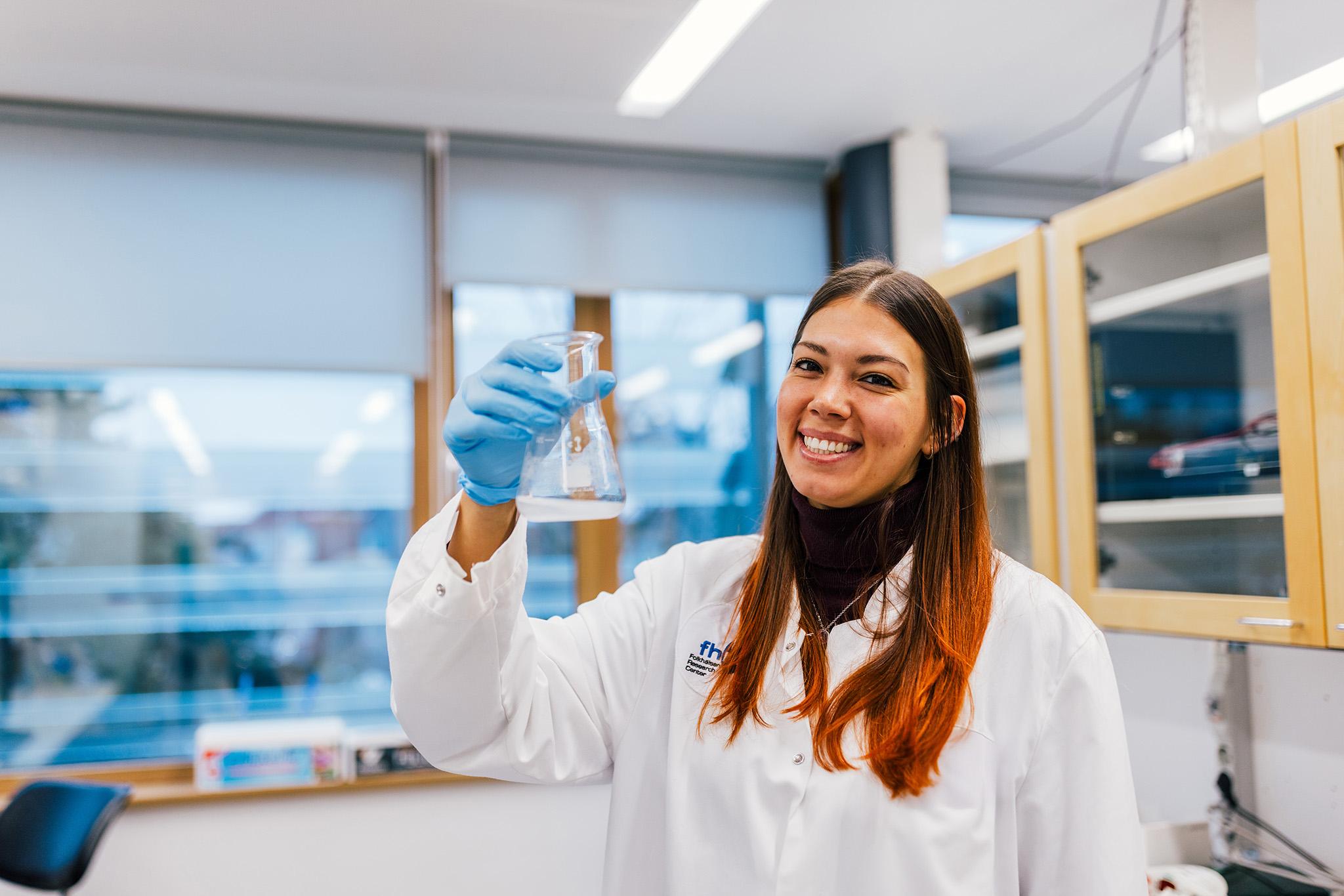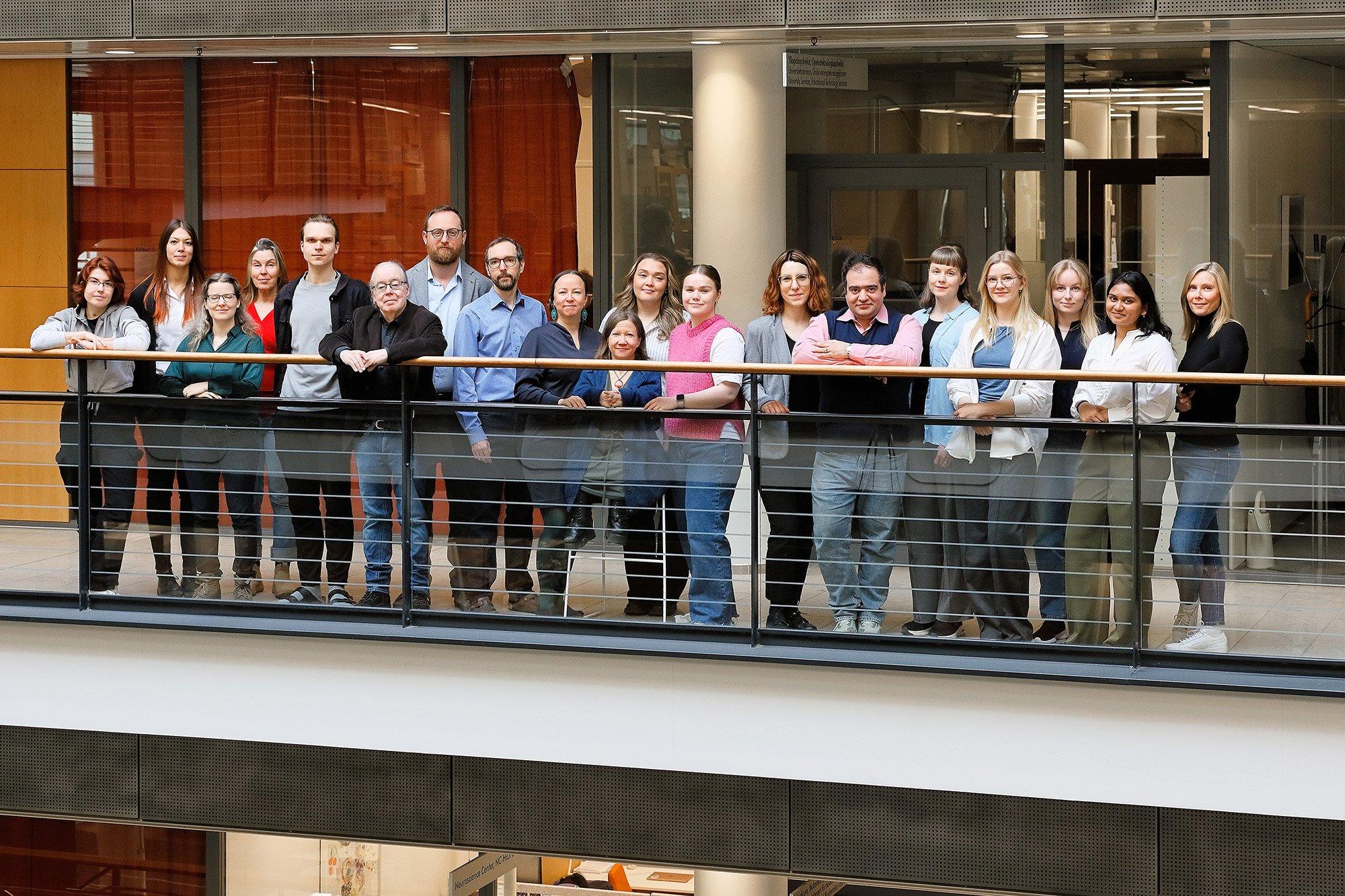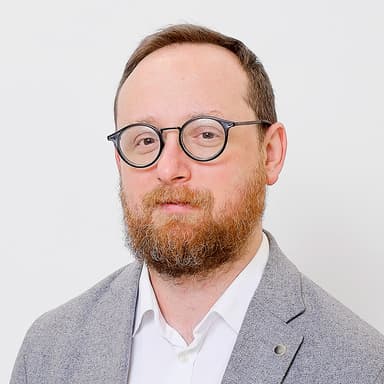
Myofin – Myology Research in Finland
Our research
We cover a wide area of research in neuromuscular disorders.
Historically we have focused on titinopathies and nemaline myopathies, but also other distal myopathies, congenital myopathies and progressive muscular dystrophies.
Our group was formed by merging three smaller muscle research groups at Folkhälsan Research Center.
One group, the former Nemaline Myopathy group, focused on nemaline myopathy (NM) and other congenital myopathies. Another group, focused on late-onset neuromuscular disorders and especially titinopathies. The third group focused on genotype-phenotype correlations. The individual groups have collaborated for years and are now merged into one, large unit covering a wide area of research in neuromuscular disorders without losing the original focus.
Rapid technological progress in genomics is reshaping the field of medical genetics, increasing the diagnostic rate, and enabling the identification of many novel disease genes. Our group has identified several novel disease genes and identified many causative variants through the years and have contributed to a better characterization of many genetic diseases affecting skeletal muscle, including titin-related myopathies, actininopathies, anoctaminopathies and nemaline myopathies to name a few, with nemaline myopathy and titinopathies historically being the primary focus areas. One of the titinopathies, tibial muscular dystrophy, is the most common muscle disease in Finland. Nemaline myopathy is the most common congenital myopathy worldwide.
![]()
To enable efficient detection of different types of variants in muscle genes, often difficult to analyse because of their size and structure, we are continuously optimising and utilizing state-of-the-art methods such as custom-made microarrays, targeted gene panels, RNA sequencing and long-read sequencing technology.
Dissect the underlying mechanism of how the heterogenous phenotypes we observe in patients with neuromuscular diseases and how causative variants in the same gene often result in a wide spectrum of phenotypes and, also how a specific clinical phenotype can be caused by variants in several different genes is a major focus area. The complex genetic architecture underlying human diseases has not been fully clarified and we still lack a clear-cut genotype–phenotype correlation for most genetic disorders. Furthermore, understanding the molecular mechanism of how identified variants disrupt the function of the encoded protein, and how the faulty protein disrupts the functioning of the muscle tissue, leading to muscle weakness is a major part of our work. To be able to offer such interpretations, we perform a wide range of functional studies and use both cellular as well as animal models.
The knowledge gattered by our work is crucial for understanding the pathogenetic mechanisms of neuromuscular disorders, facilitating the diagnostic and prognostic process. This in turn is a prerequisite for developing therapies.
Our group has a wide network of collaborating clinicians and scientist around the world and we are also involved in several large international collaboration projects.
Read more
Group Leader
Marco Savarese
Co-PIs
Peter Hackman
Katarina Pelin
Group Leader Emeriti
Bjarne Udd
Carina Wallgren-Pettersson
Senior Scientists
Per Harald Jonson
Kirsi Kiiski (part time)
Vilma-Lotta Lehtokari
Jaakko Sarparanta
Anna Vihola (part time)
Postdoctoral Researchers
Viviana Cetrangolo
Jenni Laitila
Ali Oghabian
Salla Rusanen (part time)
Veronica Sian
Doctoral Researchers
Milla Laarne
Victoria Lillback
Swethaa Natraj Gayathri
Johanna Ranta-aho
Fanny Rostedt
Affiliated medical doctors and scientists
Manu Jokela, Specialist in Neurology
Maria Francesca Di Feo, Specialist in Medical Genetics, PhD student
Staff
Ellida Holmberg (part time)
Helena Luque
Merja Soininen
Teemu Turku
Marilotta Turunen
Anna Vaino
Revealing myopathy spectrum: integrating transcriptional and clinical features of human skeletal muscles with varying health conditions.
Zhong H, Sian V, Johari M, Katayama S, Oghabian A, Jonson PH, Hackman P, Savarese M, Udd B. Communications Biology. 2024.
Missense mutations in small muscle protein X-linked (SMPX) cause distal myopathy with protein inclusions.
Johari M, Sarparanta J, Vihola A, Jonson PH, Savarese M, Jokela M, Torella A, Piluso G, Said E, Vella N, Cauchi M, Magot A, Magri F, Mauri E, Kornblum C, Reimann J, Stojkovic T, Romero NB, Luque H, Huovinen S, Lahermo P, Donner K, Comi GP, Nigro V, Hackman P, Udd B. Acta Neuropathologica. 2021.
Actininopathy: A new muscular dystrophy caused by ACTN2 dominant mutations.
Savarese M, Palmio J, Poza JJ, Weinberg J, Olive M, Cobo AM, Vihola A, Jonson PH, Sarparanta J, García-Bragado F, Urtizberea JA, Hackman P, Udd B. Annals of Neurology. 2019.
Dominantly inherited distal nemaline/cap myopathy caused by a large deletion in the nebulin gene.
Kiiski KJ, Lehtokari VL, Vihola AK, Laitila JM, Huovinen S, Sagath LJ, Evilä AE, Paetau AE, Sewry CA, Hackman PB, Pelin KB, Wallgren-Pettersson C, Udd B. Neuromuscular Disorders. 2019.
TIA1 variant drives myodegeneration in multisystem proteinopathy with SQSTM1 mutations.
Lee Y, Jonson PH, Sarparanta J, Palmio J, Sarkar M, Vihola A, Evilä A, Suominen T, Penttilä S, Savarese M, Johari M, Minot MC, Hilton-Jones D, Maddison P, Chinnery P, Reimann J, Kornblum C, Kraya T, Zierz S, Sue C, Goebel H, Azfer A, Ralston SH, Hackman P, Bucelli RC, Taylor JP, Weihl CC, Udd B. Journal of Clinical Investigation. 2018.
A recurrent copy number variation of the NEB triplicate region: only revealed by the targeted nemaline myopathy CGH array.
Kiiski K, Lehtokari VL, Löytynoja A, Ahlstén L, Laitila J, Wallgren-Pettersson C, Pelin K. European Journal of Human Genetics. 2016.
Mutations affecting the cytoplasmic functions of the co-chaperone DNAJB6 cause limb-girdle muscular dystrophy.
Sarparanta J, Jonson PH, Golzio C, Sandell S, Luque H, Screen M, McDonald K, Stajich JM, Mahjneh I, Vihola A, Raheem O, Penttilä S, Lehtinen S, Huovinen S, Palmio J, Tasca G, Ricci E, Hackman P, Hauser M, Katsanis N, Udd B.
Nature Genetics. 2012.
Distal myopathy caused by homozygous missense mutations in the nebulin gene.
Wallgren-Pettersson C, Lehtokari VL, Kalimo H, Paetau A, Nuutinen E, Hackman P, Sewry C, Pelin K, Udd B. Brain. 2007.
Tibial muscular dystrophy is a titinopathy caused by mutations in TTN, the gene encoding the giant skeletal-muscle protein titin.
Hackman P, Vihola A, Haravuori H, Marchand S, Sarparanta J, De Seze J, Labeit S, Witt C, Peltonen L, Richard I, Udd B. The American Journal of Human Genetics. 2002.
Mutations in the nebulin gene associated with autosomal recessive nemaline myopathy.
Pelin K, Hilpelä P, Donner K, Sewry C, Akkari PA, Wilton SD, Wattanasirichaigoon D, Bang ML, Centner T, Hanefeld F, Odent S, Fardeau M, Urtizberea JA, Muntoni F, Dubowitz V, Beggs AH, Laing NG, Labeit S, de la Chapelle A, Wallgren-Pettersson C. Proceedings of the National Academy of Sciences of the United States of America. 1999.
Prof. Francesco Muntoni (UCL, congenital myopathies)
Prof. Nigel Laing & Prof. Gina Ravenscroft (UWA, congenital myopathies)
Prof. Mathias Gautel (Kings' College, cardiology and biophysics)
Prof. Marco Linari (Univ. Florence, physiology)
Prof. Andreas Roos (Univ. Essen, proteomics)
Prof. Vincenzo Nigro (TIGEM, undiagnosed patients)
Prof. Coen Ottenheijm (Univ. Amsterdam, nemaline myopathies)
Assoc. Prof. Julien Ochala (University of Copenhagen, single fiber analyses)
Prof. Alan Beggs (Harvard Medical School, nemaline myopathies)
Research Council of Finland
European Union
Medicinska Understödsföreningen Liv och Hälsa (“Life and Health Medical Fund”)
Finska Läkaresällskapet (Finnish Medical Society)
Association Française contre les Myopathies
Jane and Aatos Erkko Foundation
Sigrid Jusélius Foundation
Alexandra Rundquist donation
Contact us

Marco Savarese
Group Leader
Genetics

Myofin Group
Genetics